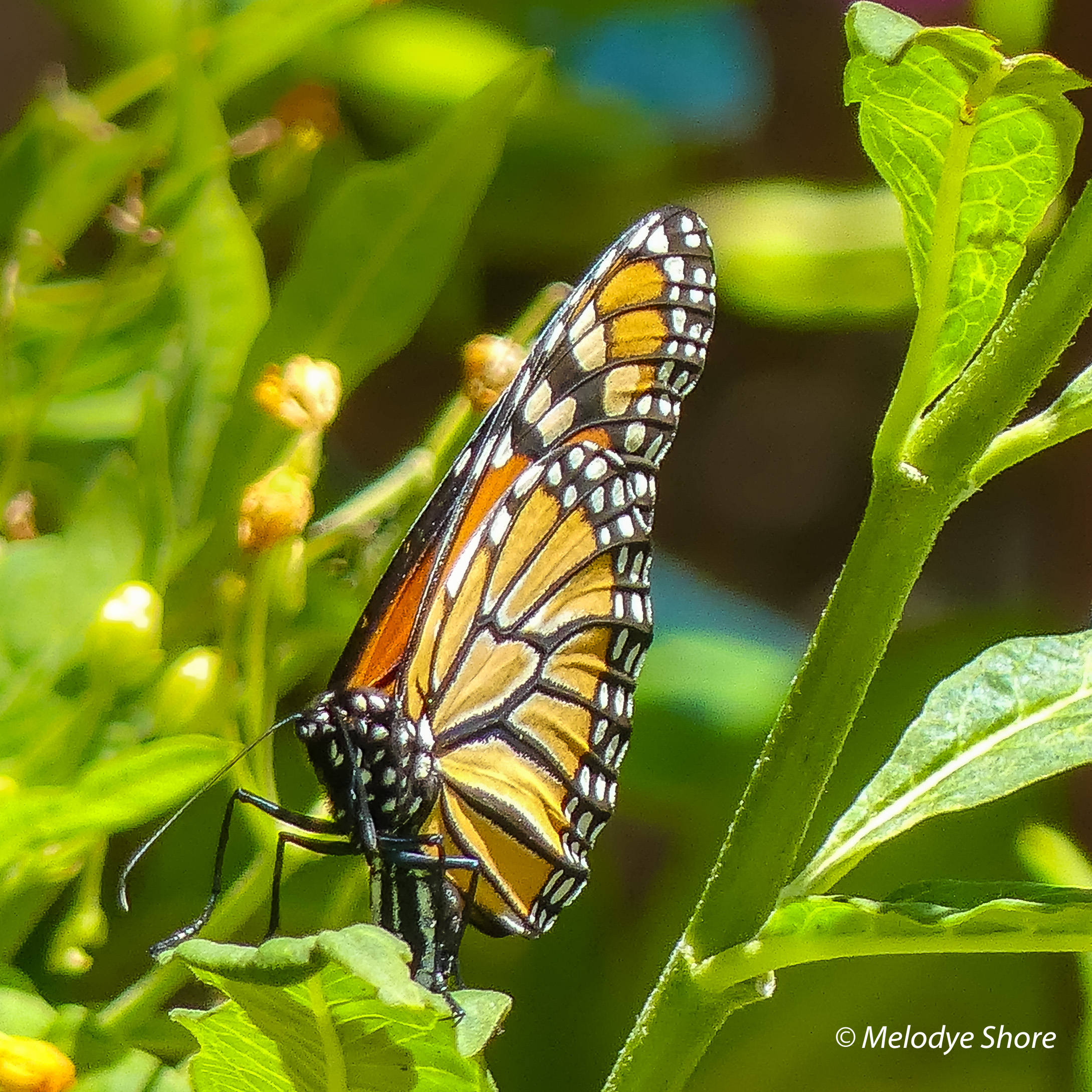We delight in the butterfly but rarely admit the changes it has gone through to achieve that beauty–Maya Angelou
I posted most of these photographs to my Facebook page, in real time, but it seems to me a miracle this grand deserves an encore performance. Enjoy!

April 1st. A Monarch butterfly visits the milkweed plant that I’ve tucked into a container garden, alongside a fuchsia.

April 27. I missed the egg stage altogether, but look! A Monarch caterpillar is munching the milkweed plant that its mother visited a few weeks back.

When I first discovered it, the very hungry caterpillar was inching its way across my backyard patio, having just discarded its skin. Ever the hovercraft watchful mama, I supervised my husband as he scooped up the butterfly-to-be with gentle hands and nestled it into soil at the base of the milkweed. Nimble little thing, it climbed to the topmost branch and started nibbling.

May 29. Cirque de Caterpillar! The J shape signals its readiness for the next phase of metamorphosis. In this photograph, it’s creating a silk pad on the underside of the fuchsia leaf, after which it’ll connect its hook-like appendage (cremaster) to the pad and twist about–an aerobatic hokey-pokey that helps ensure the cremaster is firmly attached.

Sheer magic! The caterpillar sheds its skin one last time, revealing its fragile beauty. The chrysalis hardens and dries overnight, and by daybreak, it’s transformed itself into a beautiful jade pendant, with a gold band around the top and gold flecks near the bottom.

May 30. Royal Baby Watch begins! In 9-14 days, on average, the transformation from caterpillar to butterfly will be complete. The green turns more opaque, and the golden ‘necklace’ is more pronounced. See how the tiny beads sparkle in the sunlight? Although entomologists have hypothesized about their purpose, they haven’t yet settled on an answer. Beauty sometimes exists for its own sake, am I right?

June 12. Although it’s now 3 days beyond the normal hatching period, I’m reminding myself that the transformation is sometimes delayed by cooler weather. Only 1% of Monarchs survive every stage of the egg-caterpillar-chrysallis-butterfly cycle. Grim statistics, but I’m wearing my rose-colored glasses.

June 17. Well,would you look at that! Our Monarch is a full week overdue for eclosing (“hatching”), but it looks as if its royal debut is imminent! The chrysalis turned dark green this morning, and the walls are thinning. By nightfall, barely visible but unmistakable…Monarch butterfly wings.

June 18. I’m up at dawn, so I don’t miss anything. The chrysalis is nearly black now, but pressed against the sides as they are, the wings look like stained glass windows. I take take the full measure of the chrysalis, double-check my camera equipment, and readjust my tripod.

June 18, 10:45 a.m. The chrysalis is inky black, but fully transparent, and you can see breaks along the bottom.

Cracks develop along the backside first, where the wings overlap.

June 18, approximately 11:45. Within the space of about a minute, the bottom of the chrysalis bursts open and the butterfly emerges, head first. He unfurls those gorgeous wings, climbs the nearest leaf, and rests there for about an hour. He’s helpless at this stage, given that his wings are wet, but never fear! I’m keeping an eye out for potential predators.

The emptied chrysalis is the best of form and function–truly, a work of art.

When an ocean breeze drifts through the backyard. His Royal Majesty seems to enjoy it. He turns his head from side to side, spreads and retracts his wings, clings to a fuchsia branch and wiggles his antenna.
About two hours later, he gets the urge the fly. Rough going, at first. He careens around the flowerpot. Flutter. Flap. A running start, then wheeee, he takes to the skies!
(My video’s too large to post, but you can watch his inaugural flight at this link).

The Monarch lands on the sweet pea butterfly bush at the edge of our flowerbed. He assumes elegant poses, as if to indulge this paparazzo’s fascination. My camera’s battery runs out before his patience.
The sun is directly overhead when he takes off again–flawless wings, gliding across an impossibly blue sky. I am at once wistful and ecstatic, and grateful for the opportunity to witness this metamorphosis.
Oh, and I’m happy to report that Monarch butterfly returned to my garden again this morning. I’ll be watching for tiny eggs in my milkweed plant…
UPDATE: After reading more about Monarchs this morning, I’ve changed the gender references in this post. The black pouches and thin veining on the hind wings help identify this beautiful specimen as a male. (source).













































